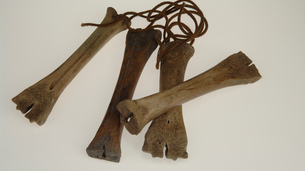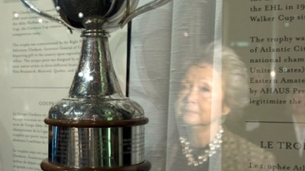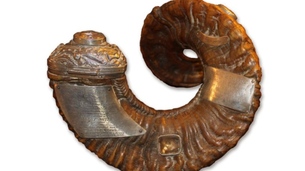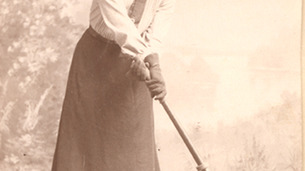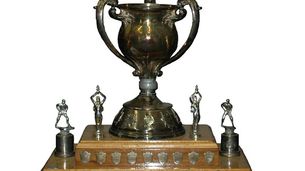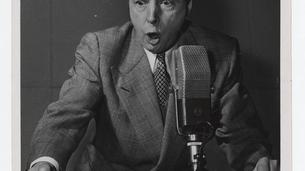
Frank J. Zamboni Wikipedia info http://en.wikipedia.org/wiki/Frank_Zamboni
1901-1988
If necessity is the mother of invention, Frank J. Zamboni might be considered its father. This tireless inventor/entrepreneur never came across an obstacle he couldn't tinker his way around.
Frank J. Zamboni was born on January 16, 1901 in Eureka, Utah. Frank's parents moved their family (with one year old Frank in tow) from Eureka to a farm in Idaho, where Frank developed his mechanical skills. For more information about the Zamboni family history, see "The Man Behind the Machine".
In 1920, Frank moved to Southern California with his brother Lawrence to join their older brother George in his auto repair business. After a short time tinkering on cars, the two younger Zambonis decided to open an electrical service business catering to the local dairy industry. The brothers built and installed the large refrigerator units dairies used to keep their milk cool.
When the demand for cooling expanded into the produce industry, the brothers expanded their business vision, as well: they built a plant that made the block ice that wholesalers used to pack their product for transport by rail across the country. But as refrigeration technology improved, demand for block ice began to shrink, and Frank and Lawrence started looking for other ways to capitalize on their expertise with ice.
That opportunity came in the sport of ice skating. Popularity of the sport was growing, but there were few rinks in Southern California, so in 1939 Frank, Lawrence, and a cousin built Iceland Skating Rink in Paramount. (The rink still operates today just blocks from the Zamboni factory. In fact, it's not unusual to see Zamboni ice resurfacers driving down the neighborhood streets on their way to be tested at Iceland.)


Iceland opened in 1940 as one of the largest rinks in the country, with 20,000 sq. ft. of iced surface -- that's enough room for 800 skaters. The original rink was an open-air facility. But the brothers soon learned that, with the intense Southern California sun and dry desert winds, the quality of their ice sheet was less than adequate, so they covered it with a domed roof. The challenge now was to maintain this much-improved indoor surface. More about Paramount Iceland.
At the time, resurfacing the ice meant pulling a scraper behind a tractor, shaving the surface. Three or four workers would scoop away the shavings, spray water over the surface, squeegee it clean and allow the water to freeze -- a process that took more than an hour. For Frank, it was a puzzle to be solved: how could he make a good sheet of ice in a short period of time? It wasn't long before he began engineering a machine that would make the task of ice-resurfacing fast and efficient. And the concept of the Zamboni ice resurfacer was born...

In March of 1942, Frank bought a tractor and started experimenting. His first attempt -- a machine built into a sled towed behind a tractor -- neither smoothed the surface nor picked up the "snow" adequately. Repeated experiments with the design proved fruitless. But Frank had another idea, and in 1947 he began tinkering with a completely different approach: a machine that would shave the ice, remove the shavings, wash and squeegee the ice, and hold snow in an elevated tank large enough to last for an entire resurfacing job.
This prototype was built at the rear of Iceland skating rink in Paramount, California. The machine had water tanks in the front and a snow tank at the rear. Only the front wheels were powered and for this he used a front steering axel from a war surplus truck. The unit was powered by a Jeep engine and transmission that were also purchased from war surplus. On this chassis, he tried different conveyor systems including the paddle and chain that is shown in the above photograph. He abandoned experimental prototype No. 3 in late 1947 as unsuccessful, because the blade chattered, the snow tank did not carry enough snow and he found that it was impractical to run the two-wheel drive machine on the ice unless it had tire chains for traction.
To overcome the inadequacies he encountered on experimental Model No. 3, Frank decided to develop a completely new design. For this machine, he purchased another surplus front steering truck axel so he would have both four-wheel drive and four-wheel steering. In addition, parts from the previous prototype were used in building the new machine. The new machine's adjustable blade could be held firmly in place by the operator, thus keeping it from chattering or digging into the ice.
By the summer of 1949 he was able to get a good sheet of ice consistently, and the "Model A Zamboni Ice Resurfacer" became a working reality. Frank applied for a patent and in 1953, Patent Application No. 93,478 was granted by the United States Patent and Trademark Office..

Model A (1949)
The first Zamboni ice-resurfacing machine, built and used at the Paramount Iceland Skating Rink, had four-wheel drive and four-wheel steering on a hand-built chassis using war surplus axles and engine parts. The surplus parts actually include a hydraulic cylinder from either a Douglas A-20 or A-26 bomber. The Model A was built, tested, modified and retested at Paramount Iceland. A cover was added at the front over the conveyor chain to keep snow from falling onto the fresh ice surface. It also had an in-tank snow-melting system along with a wash water system. Early photos of the machine show a different configuration of the large wooden snow tank, prior to its modification. The wooden side was hinged so snow could be shoveled out.
The Model A introduced the "Wash Water" system -- a black tank over the galvanized water tank dropped water into a distributor pulled on the ice at the rear that washed the ice before being pumped back into the bucket. The system duplicated the process of washing the ice that was previously accomplished by several people using a large hose and squeegees over the entire rink surface. The washing operation was necessary to clean the ice prior to applying the final coat of water, greatly enhancing the finished sheet of ice. The concept was incorporated into Frank's basic and broadest patent (2,642,679), which was incorporated into many of the ice resurfacer models manufactured by Zamboni. Eventually, the Model A's snow tank was modified for a more "finished" appearance. One important change made by Frank to the Model A was the elimination of the original four-wheel steering.
When using the Model A equipped with four-wheel steering on his rink, he discovered that when the machine was driven close to the boards and the operator tried to steer away from them, the rear wheels would steer into the wall while the front wheels turned away, thus jamming the machine against the wall until it could be pushed sideways to free it. He disconnected the steering on the rear axel and the problem disappeared. He decided that the best configuration would have four-wheel drive and two-wheel front steering, which made the Jeep an ideal chassis on which to build later models.
During its term of service, the Model A was never used on any ice surface other than Paramount Iceland's. It was taken out of service and replaced by a newer model in 1953. After a number of years, the snow tank was dismantled to accommodate movement around the side of the rink and under the angular concrete pillar supporting its roof. In 1996, the machine began a lengthy restoration process and has been restored to its original condition. The machine normally resides at Paramount Iceland, adjacent to the rink.

Model B (1950)
In 1950, Olympic skating star Sonja Henie's traveling ice show was practicing at Paramount Iceland, and she saw the Model A in action. She had to have one and asked Frank if he could build one in time for an upcoming Chicago performance. The deadline was tough, but Frank worked day and night, then loaded all of the resurfacer parts into a U-Haul® trailer. He towed the trailer to Chicago behind the Jeep he would install the parts on and assembled the Model B there.
A total of four Model B machines were built: The Pasadena, Calif., Winter Garden purchased the first; Sonja ordered two, one of which ended up on tour with her in Europe (and was eventually dismantled there); and Ice Capades purchased the fourth -- a machine that was restored and has spent many years on display at the Hockey Hall of Fame in Eveleth, Minnesota. Read about the Odyssey of Machine No. 4. With orders arriving for the Model B machines, Frank founded the Frank J. Zamboni Company.
In fact, Frank Zamboni wanted to call his company The Paramount Engineering Company, after the city he helped name, but that name had been taken. So he named the company after himself, knowing there could be no disputing a name that belonged to him. Good thing -- can you imagine someone shouting, "Look, here comes the Paramount!"?

Model C
The next generation of Zamboni machines, still built on a complete Jeep®, had significant design changes. Frank elevated the driver's position and dropped the snow tank to allow better driver visibility and greater snow capacity. The first of the series was the Model C.
In a memorable incident, Frank drove one of his Model C machines 450 miles up the coast of California to Berkeley Iceland. Read more about Berkeley Iceland. Along the way, a key came out of the steering wheel shaft, and Frank lost steering control. The machine, with him driving, veered off into the oleander bushes on the highway median and stopped. Frank managed to get the key back into the shaft, however, and proceeded on to deliver the machine.
The second of the series was the Model D -- a machine differing only slightly from the Model C. The Model D's redesigned dump tank had a "stepped" look. The change did not affect or enhance operation, however, and was later shelved. The third machine was the Model E.

Model E (1954)
Introduced in 1954, the Model E was the first Zamboni machine that could be mass produced. Between 1954 and 1955, 20 of these models were manufactured and sold. The first use of a Zamboni machine for an NHL game has been the subject of discussion for many years, so Zamboni contacted Bob Skrak who helped Frank Zamboni in the early days. Bob actually took machines around the country to introduce the arena managers to the "invention", which could significantly improve their ice sheet's surface and enhance the quality of the ice for skating and hockey.
Bob worked for Ice Capades and would use the Zamboni machine (No. 4 primarily) to resurface for the ice shows. On New Years Day in 1954, Bob was on hand in the Boston Garden for the ice show and there was an NHL Bruins hockey game to be played that day in the arena. Bob took the machine out on the ice and resurfaced for the Bruins game and the management was impressed with the results. The only thing that stood in the way of having a machine on hand in the arena: that they would have to take out seats from the arena's configuration to accommodate a machine going out on to the ice, as the arenas were not originally designed with room for the machine to navigate from its storage area to the ice surface.
The Bruins ordered a machine and according to our records, it was delivered in the Fall of 1954 for the team�s use. In 1988, the Boston Bruins had a new Zamboni machine on order and requested that the vintage machine, Model E 21 be fully restored by the Zamboni Company. When the restored machine was delivered and turned over in an on ice ceremony at Boston Garden, it was announced that E 21 would be delivered to the Hockey Hall of Fame as a part of their historic collection in Toronto, Canada.
In the mid-50s, the popularity of ice skating increased dramatically, as did new rink construction. Frank found that rink owners wanted machines with more snow and water capacity, so he redesigned the resurfacer, abandoned a complete Jeep as a platform, and substituted a Jeep chassis that he bought directly from the Willys factory.

Model F (1956)
In 1956, Frank redesigned the machine using a stripped Jeep chassis. By using the chassis as a foundation, Frank was able to increase both water- and snow-carrying capacities. On some versions of the Model F, he extended the panels on the sides of the machine and raised the snow tank by 6 inches -- an adaptation that added 20 cubic feet. This gave his customers the extra capacity they needed.
See the old Model F in action. (1.3mb MPEG movie.)

HD Series (1964)
Frank never stopped experimenting with new innovations and enhancements. In 1964, he introduced the HD Series, with its completely new vertical auger system to convey the snow and a quick-dumping snow tank. The revolutionary aspects of the HD remain the standard of the industry today -- more than 30 years after they were brought to market.The Model HD
was the first production dumping machine
not built on a Jeep chassis
500 Series (1978 to Present)
The 500 Series introduced the liquid-cooled engine vs. earlier air-cooled systems. And with the 552 came another new technology: it's a fully electric machine, using battery technology. The Model 500 and Model 552 are the series of Zamboni machines most commonly used on the ice today. The combination of the Winter Olympics and televised sports has had a tremendous impact on the ice skating industry. From Sonja Henie and her Olympic achievements, to ice show performances around the world, to the continued growth in popularity of ice hockey -- the Zamboni machine comes into the lives and homes of ice sport enthusiasts everywhere.
From the 1949 Model A to the 500 Series resurfacers of today, Frank Zamboni's desire to develop the best possible product for his first customers remains as strong in his successors over 50 years later. As Frank often pointed out to rink owners, a comment indicative of his own lifelong mission: "The principal product you have to sell is the ice itself."

This article is from http://Zamboni.com
More Unusual Photos:
CJ-3B's on Ice
Zamboni® Ice Re-Surfacing Machines

This photo shows Zamboni® #12 (Model D, 1953), built for Holiday On Ice. Note the use of tires with minimum tread, and the stock driver's seat and steering wheel moved to the upper rear driving position. Photo © Zamboni, 1999. Zamboni® is a registered trademark of Frank J. Zamboni & Co., Inc.



By the way, Zamboni® has another thing in common with Jeep® -- they are both registered names for an original, unique vehicle. Their manufacturers are justly proud of the names, and want to make sure that people don't forget that they are the originals and start using those names as generic terms for other similar vehicles.

Thanks to the staff at Frank J. Zamboni & Co., Inc. for their assistance. For more on the company, and more photos of earlier and later models, see the Zamboni.com website. -- Derek Redmond

